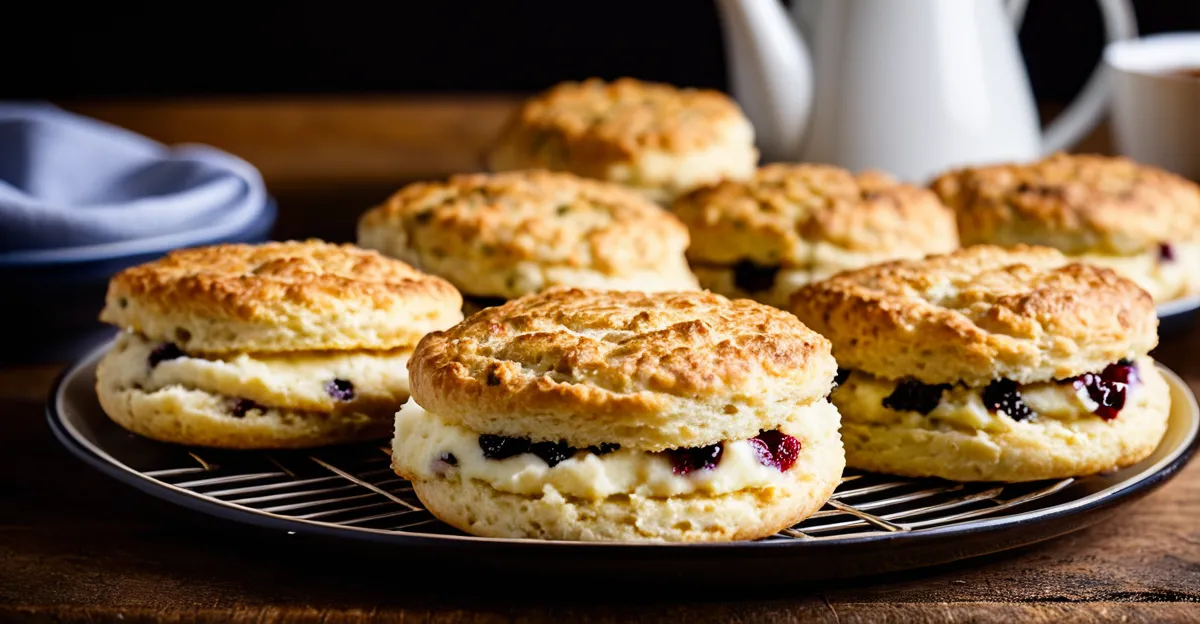Essential Ingredients for Traditional British Scones
The foundation of authentic British scones relies heavily on authentic scone ingredients, the most crucial being self-raising flour. This type of flour is pre-mixed with leavening agents, which significantly impacts the scone’s light, tender texture by ensuring an even rise during baking. Using plain flour instead often leads to denser results, missing that classic British scone fluffiness.
Another key component is cold butter, often sourced from high-quality butter with about 82% fat content. Keeping the butter cold is vital because when it is cut into the flour mixture, it creates tiny pockets of fat. As the scones bake, these pockets release steam, resulting in the desired flaky layers that are the hallmark of well-made British scones. Warm or melted butter won’t provide this effect, leading to a denser, less crumbly texture.
This might interest you : How do you achieve the perfect texture in a homemade Lancashire hotpot?
Full-fat milk and fresh eggs contribute richness and moisture, rounding out the recipe. The milk adds tenderness, while eggs help bind the dough without making it heavy, ensuring a balanced crumb. For authentic British scones, these ingredients must be used in the right proportions and handled gently to maintain the integrity of the dough before baking.
Proven Techniques for Achieving Perfect Scone Texture
Achieving the ideal light texture in British scones starts with mastering scone mixing techniques. The key is gentle mixing. Overworking the dough activates gluten, resulting in tough, dense scones. Instead, mix ingredients just until combined to keep the crumb tender and flaky.
In the same genre : How can you recreate a traditional English afternoon tea at home?
Cutting cold butter into the flour is essential. This method creates small fat pockets that melt during baking, releasing steam and producing the crumbly texture characteristic of authentic scones. Use a pastry cutter or fingertips for this, ensuring the butter remains cold and visible in small pieces within the dough.
Shaping scones evenly and choosing the right thickness also influence texture. A thickness around 2cm promotes an even rise without undercooked centers. Avoid rolling the dough too thin, which can lead to dry scones.
Expert scone baking tips emphasize chilling the dough briefly before baking. This allows the butter to firm up again, enhancing flakiness during baking.
By focusing on these scone mixing techniques and handling steps, bakers can consistently produce British scones with that perfect balance of tenderness and crumbly, flaky layers. This craftsmanship turns simple ingredients into a delightful treat.
Baking and Presentation Best Practices
Achieving perfect British scones hinges on precise baking British scones methods and ideal oven settings. The recommended oven temperature for scones is typically between 210°C and 220°C (410°F to 428°F). This high heat promotes a rapid rise, creating a tender crumb and a golden crust. Baking time usually ranges from 12 to 15 minutes, but keeping a close watch helps prevent overbaking and dryness.
For consistently golden tops and an even rise, preheat the oven fully and place scones on a middle rack. This positioning ensures balanced heat exposure. Additionally, brushing the scone tops lightly with milk or beaten egg just before baking enhances their shine and colour.
Scone presentation is all about simplicity and tradition. Serve scones warm with classic accompaniments like clotted cream and homemade jam. Arrange them neatly on a tiered stand or a plain plate for an authentic feel. Using fresh linen napkins or doilies adds a touch of British elegance without complicating the visual appeal.
These baking British scones strategies, from oven control to classic presentation, help deliver scones that look irresistible and taste truly authentic.
Classic Accompaniments and Toppings
Accompanying British scones with the right scone toppings enhances their traditional charm and flavor. The quintessential pair is traditional clotted cream and homemade jam for scones. Clotted cream, rich and velvety, offers a luxurious mouthfeel that complements the tender crumb. It is usually spread generously before adding dollops of sweet preserves, with strawberry or raspberry jam being classic favorites.
Pairing these toppings with a quality tea elevates the experience further. Earl Grey or Darjeeling teas work well, balancing the scones’ richness with their subtle floral or citrus notes. This combination has deep roots in British tea culture, making it both authentic and delightful.
Presentation matters: serve scones warm, with separate dishes for clotted cream and jams to let guests choose their preference. Using simple, elegant serving ware keeps the focus on the scones and their toppings, upholding the traditional cream tea aesthetic.
Exploring these scone toppings not only respects British baking heritage but also encourages a sensory experience that highlights every element of the perfect scone bite—from the crumbly base to the silky cream and luscious jam. This classic foundation invites both newcomers and aficionados to enjoy scones as they were meant to be savored.
Avoiding Common Mistakes in Scone Making
Carefully avoiding scone baking mistakes is key to perfecting British scones. One frequent error is overmixing the dough. When kneaded too much, gluten develops excessively, producing dense, tough scones instead of the desired lightness. Gentle folding and minimal mixing ensure a tender crumb.
Choosing the right flour matters greatly. Using self-raising flour is crucial; its built-in leavening agents guarantee proper rise. Plain flour lacks these, often resulting in flat scones. The dough should be handled minimally to prevent toughening, working just enough to combine ingredients.
Common pitfalls also include neglecting ingredient temperature. For instance, not using cold butter leads to insufficient flaky layers, as butter melts too soon and fails to create steam pockets during baking. Properly chilled butter helps achieve that classic crumbly texture.
To avoid dry or flat scones, maintain correct oven temperature and avoid overbaking. Watch the colour and test lightly for doneness. If scones feel dry, adjust moisture with correct proportions of milk and eggs in future batches.
By troubleshooting these issues thoughtfully, bakers can consistently improve their results and produce British scones exhibiting perfect rise, crumb, and moisture balance.

